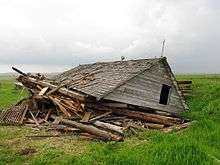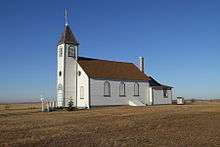Hungarian Canadians
|
| |
| Total population | |
|---|---|
|
316,765 (by ancestry, 2011 Census) | |
| Regions with significant populations | |
| Ontario | 151,750 (1.3 %) |
| Alberta | 48,655 (1.48 %) |
| British Columbia | 43,515 (1.12 %) |
| Saskatchewan | 24,400 (2.5 %) |
| Quebec | 16,490 (0.23 %) |
| Newfoundland and Labrador | 245 (0.05 %) |
| Prince Edward Island | 415 (0.30 %) |
| Languages | |
| Canadian English, Hungarian, Canadian French | |
| Religion | |
| Catholic, Reformed | |
| Related ethnic groups | |
| Hungarians | |
Hungarian Canadians (Hungarian: Kanadai magyarok) are persons in Canada of Hungarian ancestry. According to the Canada 2011 Census, there are 316,765 Canadians of Hungarian ancestry.[1] The Hungarian minority is the 23rd largest ethnic group of Canada. The bulk of Hungarian immigration occurred after World War II, with the wave peaking after the 1956 Hungarian revolution against communist rule, when over 100,000 Hungarian refugees went to Canada. The Hungarian-Canadian community is among the country's multiple ethnicities; Canada is one of the top five countries of the Hungarian diaspora.
Alberta
After the Canada 2006 Census 48,665 people (1,48% of the population) have Hungarian roots and 6,770 of them speak the Hungarian language (0.21%).[2]

The first Hungarians arrived in Alberta in 1866 with Count Paul Oskar Eszterhazy, who wanted Hungarians to re-settle after they had emigrated originally to Pennsylvania. The memorial of János Mráz, in 1895 in Bashaw indicated that there were already 25 Hungarian families, each of which farmed a homestead.[3] The 1900 Census counted 167 Hungarians in the Lethbridge area.
A larger influx of immigrants into Alberta is recorded in 1914-1915. At that time 300 Hungarian labourers arrived in the area. In the 1930s there was a greater immigration wave to Alberta. In 1921 there lived 1045 Hungarians there, in 1931 this number was 5502.[3]
Saskatchewan
The Canada 2006 Census showed 27,395 people living in Saskatchewan who have Hungarian roots or were born in Hungary.[4] In local, oral Hungarian usage the name of the province was Saskanada.[5]
By 1921 the Hungarian population grew to 8,946, in 1931 to 13,363, and in 1941 to 14,576. Because of migration to Ontario and eastern Canada, the population declined to 12,470 by 1951. In 2001 there lived 24,340 Hungarians in Saskatchewan, of whom 24% (5,875 people) claimed to be born in Hungary.[6]
Significant Hungarian populations exist in the Saskatchewan settlements of: St. Benedict, Prud'homme, Yellow Creek, Zichydorf, East Central, Cudworth, Whitewood and Mistatim.

In 1885 the Hungarian immigrants established several settlements in the eastern region of Saskatchewan. One of them was Esterhaz colony, which still exists. In 1888 a new settlement was founded near Esterhazy, which was named Kaposvár (named after Kaposvár, now part of Esterhazy). By 1902 these two settlements had over 900 people.[6] The nearby Stockholm also became Hungarian settlement (in Hungarian Sokhalom). In 1894 a Hungarian settlement was established Rev. Janos (John) Kovacs in Otthon (which means 'Home'). After 1902 somewhere the current town of Kipling there was a settlement called Békevár ('Peaceburgh').[6] Later Hungarians settled down also in the northern part of Saskatchewan, close to Wakaw, there was the Buda School District. West of Wakaw was the Dunafoldvar district (named after Dunaföldvár), south of Wakaw was Matyasfold (Mátyásföld - 'Land of Matthew').[6]
Manitoba
After the Canada 2006 Census there were 9,900 people in Manitoba who have Hungarian roots or were born in Hungary.[4] In 1996 there lived 9,025 Hungarians in Manitoba.[7]
The first wave of the Hungarian immigrants reached Manitoba in 1885, many of whom settled in or near Winnipeg. In 1906 the Hungarian Presbyterian church was established there. The first Hungarian newspaper in Canada was published in Winnipeg in 1905: Kanadai Magyarság ('Canadian Hungarians').[8] During the First World War, citizens of enemy allies were interned. Between 1918 and 1924 the Hungarian clubs in Winnipeg were very active. By 1920 there were only 13,181 Hungarians in the whole country, most of them in Saskatchewan, only a few in Manitoba. The second wave of the immigration came during the inter-war years. The new immigrants established to Roman Catholic church and the Protestant church in 1924. A new newspaper was founded: Kanadai Magyar Újság ('Canadian Hungarian Newspaper'). In 1927 Hungarian consulate was opened in Winnipeg.
Ontario
The Canada 2006 Census counted 151,750 people in Ontario who have Hungarian roots or were born in Hungary.[9] They account for 1.3% of the population. More recently, 53,000 Hungarians live in Toronto.[10]
Most of the Hungarians lived in Welland, Windsor, Brantford and in Hamilton.[11] In 1931, more than 1,000 Hungarians lived in Hamilton, Toronto and in Welland. There were significant Hungarian populations in Brantford, Kitchener, Oshawa, St. Catharines, Niagara Falls and in Port Colborne. Many Hungarians worked at the construction of the Welland Canal.[12] By 1961 Hungarians accounted for 40% of the population of Welland.[13]
After the First World War thousands of Hungarians emigrated to Canada, especially from the rural classes. After the Second World War people from several classes came to the country. Ontario's climate was similar in some ways to the Hungarian climate so people from the Great Hungarian Plain moved to Ontario. The first Hungarians (60 people) to arrive in Welland did so in 1906.[13] The first Hungarian society was established in Hamilton in 1907, the second was founded in Hamilton in 1913. In 1921 the Hungarian Self Culture Society was established in Welland[12] where the first Hungarian newspaper was also published in 1928.[14] In 1931 the three-fourths of the Hungarian Canadian population lived in Ontario.[11] The 1956 refugees also lifted the Hungarian population in Canada. In 1949 a so-called Delhi & Tobacco District Hungarian House was dedicated in Delhi-Tillsonburg, the centre was initiated by Paul Rapai in 1947. 40 percent (about 1,500 people) of the tobacco factory was Hungarian.[15] In 1933 two Hungarian newspapers were established by Rapai, the Kanadai Magyar Újság and the Wellandi Kisújság.[16] After 1956 abouth 6,000 refugees arrived in Ontario.[15] In 1964 a Roman Catholic church was built in London, Ontario. Roman Catholic churches are still in Toronto, Hamilton and in Courtland. There are still four Greek Catholic churches in Ontario: in Welland, Courtland, Windsor and in Hamilton. Presbyterian churches are in Delhi and in Ottawa.[17]
Prince Edward Island
1956-1957 saw a large wave of Hungarian migration to Prince Edward Island, and probably the largest ever. A special Emergency Relief Committee was established to manage the arrival of Hungarian refugees, led by Minister of Health M.L. Bonnell.[18] In addition to a reception centre which was established in Falconwood, a number of other groups participated in supporting the settlement of the Hungarians including the province's Red Cross, Women's Institute, Catholic Women's League, as well local volunteer doctors and nurses.[19]
In general, the Hungarians were welcomed to the province, as reported by The Guardian Newspaper. It was believed that the Hungarians were the "right type" of immigrant and could contribute to the province's agricultural sector.
Gallery
 Kaposvar historical site outside of the Town of Esterhazy
Kaposvar historical site outside of the Town of Esterhazy Photo of the Esterhazy Flour Mill on December 11, 2011
Photo of the Esterhazy Flour Mill on December 11, 2011 Embassy of Hungary in Ottawa, Canada
Embassy of Hungary in Ottawa, Canada
See also
References
- ↑ "Statistics Canada". 2.statcan.ca. 2010-10-06. Retrieved 2013-07-02.
- ↑ "Ethnocultural Portrait of Canada, 2006". Statistics Canada. Retrieved 2010-02-15.
- 1 2 Steven Tötösy de Zepetnek: Towards the History of Hungarians in Alberta, 1999
- 1 2 "Ethnocultural Portrait of Canada, 2006". Statistics Canada. Retrieved 2010-02-15.
- ↑ "Az emigráns amerikai magyarok jellegzetes 'hunglish' szókincse". Bakó Ferenc: Kanadai magyarok. Retrieved 2010-02-15.
- 1 2 3 4 "Hungarian settlements". The Encyclopedia of Saskatchewan. Retrieved 2010-02-15.
- ↑ "Az 1996. évi kanadai népszámlálás adataiból". Retrieved 2010-02-15.
- ↑ "Address to the Commemoration in Winnipeg of the 50th Anniversary of the Hungarian Uprising: 22 October 2006". Retrieved 2006-10-22.
- ↑ "Ethnocultural Portrait of Canada, 2006". Statistics Canada. Retrieved 2010-02-15.
- ↑ "Toronto's Hungarian Community". Heritage Toronto. Retrieved 2010-02-15.
- 1 2 Papp 1980: 3
- 1 2 Papp 1980: 8
- 1 2 "Ethnic history of Welland". Retrieved 2010-02-15.
- ↑ Papp, Susan M (Spring–Summer 1982). "Hungarian press in Ontario". Polyphony: The Bulletin of the Multicultural History Society of Ontario. 4 (1): 64. Retrieved 2 August 2013.
- 1 2 Papp 1980: 84
- ↑ Papp 1980 :81
- ↑ Papp 1980: 50
- ↑ Cameron, Bobby Thomas.(2014).The Migration of Hungarian Refugees to Prince Edward Island, Canada (1956-1957) KOME: An International Journal of Pure Communication Inquiry 2 (2), 17-25.
- ↑ Cameron, Bobby Thomas.(2014).The Migration of Hungarian Refugees to Prince Edward Island, Canada (1956-1957). pp 20-21
Susan M. Papp (1980). Hungarians in Ontario. Toronto.
External links
| Wikimedia Commons has media related to Canadians of Hungarian descent. |
- Hungarian immigrants in interwar Canada
- Digitized issues of the Kanadai Magyar Munkás (Canadian-Hungarian Worker), 1929-1967
- 1956 Hungarian Memorial Oral History Project
- Hunagrian Refugees Received on Prince Edward Island, Canada (1956-1957)
- Hungarian settlements in Saskatchewan
- Life as it was : Prud'homme, Saskatchewan, 1897-1981
- Karpat Hungarian Folk Dancers of Winnipeg
- Address to the Commemoration in Winnipeg of the 50th Anniversary of the Hungarian Uprising: 22 October 2006
- Toronto's Hungarian Community
- Ottawa Hungarian Community Centre
- The Free Magyar Reformed Church in Ontario
- Susan M. Papp: Hungarians in Ontario
- Arany Janos Hungarian School in Hamilton
- Hungarian TV in Toronto
- Hungarian Radio in Toronto
